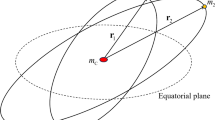Summary
The purpose of this note is to investigate the geodesic motion in the gravitational field of a rotating source, making use of the exact empty-space solutions of Einstein’s equations given by Kerr. The earlier weak-field approximate solutions of Lense and Thirring for a rotating body are also examined to compare them with the exact case and with the Schwarzschild nonrotating one, whose geodesic properties are also briefly summarized. The behaviour of single orbits, for example the precession of the pericenter, will not be mentioned since they have been extensively analysed in the cited references. The differential equations of the geodesics are analysed from an analytical point of view in order to recognize the shape of the loci of the turning points for the test particles without introducing numerical values of the parameters involved such asa (specific angular momentum of the rotating body) andΓ (test particle’s effective energy). Diagrams are given which show the behaviour of the geodesics for different ranges of these parameters. An attempt to make a physical comparison between these three cases has been done in the last Section.
Riassunto
Scopo della presente nota è di analizzare il moto geodesico nel campo gravitazionale di una sorgente rotante facendo uso delle soluzioni delle equazioni di Einstein dedotte da Kerr. Si esaminano le soluzioni di campo debole per un corpo rotante fornite da Lense e Thirring, e si confrontano queste con quelle esatte di Kerr e con il campo di Schwarzschild le cui proprietà geodesiche sono anche brevemente riassunte. Il comportamento caratteristico delle singole orbite, come la precessione del perielio, non vieue preso in esame essendo ampiamente descritto nella bibliografia indicata. Le equazioni differenziali delle geodesiche sono esaminate da un punto di vista analitico in modo da poter tracciare i luoghi dei punti di inversione delle orbite delle particelle di prova senza introdurre valori numerici dei parametri in gioco comea (momento angolare del corpo rotante) e Γ (energia della particella di prova). Il comportamento delle orbite per differenti valori di questi parametri è mostrato in una serie di diagrammi. Un tentativo di confrontare questi tre tipi di soluzioni è contenuto nell’ultima Sezione.
Реэюме
Цель зтой эаметки исследовать геодеэическое движение в гравитационном поле врашаюшегося источника, испольэуя точные рещения уравнений Эйнщтейна для пустого пространства, полученные Керром. Также иэучаются более ранние приближенные рещения Ленса и Тирринга в слабом поле для врашаюшегося тела, чтобы сравнить их с точным случаем и со случаем Щварцщильда для невра-шаюшегося тела, причем, также вкратце суммируются геодеэические свойства последнего. Поведение отдельных орбит, например, прецессия перицентра, не будет рассматриваться, т.к. они были интенсивно исследованы в цитированных ссылках. С аналитической точки эрения аналиэируются дифференциальные уравнения геодеэии, для того, чтобы уэнать форму точек поворота для пробных частиц беэ введения численных эначений испольэованных параметров, таких как а (удельный момент врашеюшегося тела) и Г (зффективная знергия пробной частицы). Приводятся диаграммы, которые покаэывают поведение геодеэии для раэличных областей зтих параметров. В последнем раэделе была сделана попытка провести фиэическое сравнение между зтими тремя случаями.
Similar content being viewed by others
References
L. Landau andE. M. Lifshitz:Classical Theory of Fields (London, 1962.)
See ref. (1) for a suitable discussion.
J. L. Synge:Mont. Not. Roy. Astr. Soc.,131, 463 (1966).
C. Darwin:Proc. Roy. Soc.,249, 180 (1958).
C. Darwin:Proc. Roy. Soc.,263, 39 (1958).
B. Mielnik andJ. Plebanski:Acta Phys. Pol.,21, 239 (1962).
G. C. McVittie:General Relativity and Cosmology (London, 1964).
T. Infeld andJ. Plebanski:Motion and Relativity (London, 1960).
Y. Hagihara:Jap. Journ. Astr. Geophys.,8, 67 (1931).
B. Kuchowicz:Repts. of Univ. of Warsaw (1965).
In this caseγ=1 is the energy of a particle at rest at infinity (1,10).
K. S. Thorne:Proc. S.I.F., Course XXXV (New York and London, 1966), p. 166.
Ya. B. Zel’Dovich andI. D. Novikov:Sov. Phys. Uspeki,8, 522 (1965).
B. Carter:Phys. Rev.,141, 1242 (1966).
D. Finkelstein:Phys. Rev.,110, 965 (1958).
A. Einstein:The Meaning of Relativity (1950).
In particular forΓ=0, ‖λ extr‖=2
R. H. Boyer andR. W. Lindquist:Journ. Math. Phys.,8, 265 (1967).
R. P. Kerr:Phys. Rev. Lett.,11, 238 (1963).
R. H. Boyer andT. G. Price:Proc. Cambridge Phil. Soc.,61, 531 (1965).
A. S. Eddington:Nature,113, 192 (1924).
B. Carter:The global structure of the Kerr family of gravitational fields, preprint (1967).
A. Trautman, F. A. E. Pirani andH. Bondi:Lectures on General Relativity, Brandeis Summer Institute (1964).
W. Pauli:Theory of Relativity (London, 1958).
J. Lense andH. Thirring:Phys. Zeits.,19, 156 (1918).
The co-ordinates in use arex 1=x, x 2=y, x 3=z, x 4=it (22).
R. H. Boyer:Proc. Camb. Phil. Soc.,61, 527 (1965).
Author information
Authors and Affiliations
Rights and permissions
About this article
Cite this article
de Felice, F. Equatorial geodesic motion in the gravitational field of a rotating source. Nuovo Cimento B (1965-1970) 57, 351–388 (1968). https://doi.org/10.1007/BF02710207
Received:
Published:
Issue Date:
DOI: https://doi.org/10.1007/BF02710207




